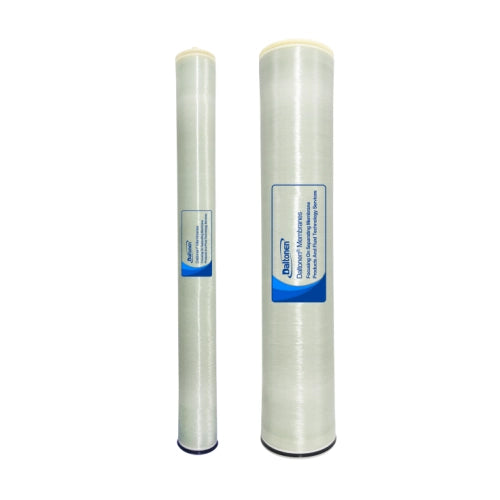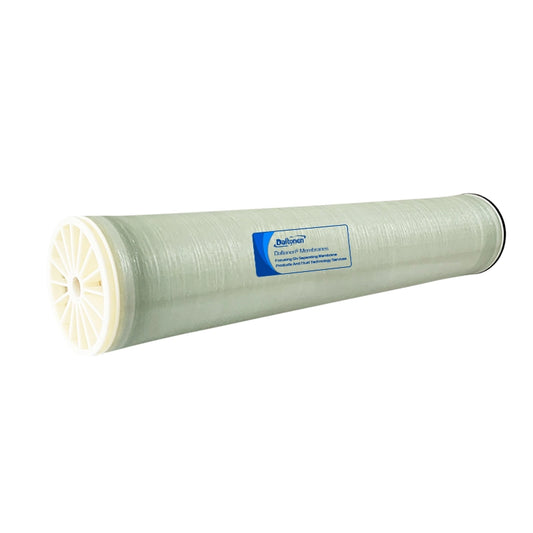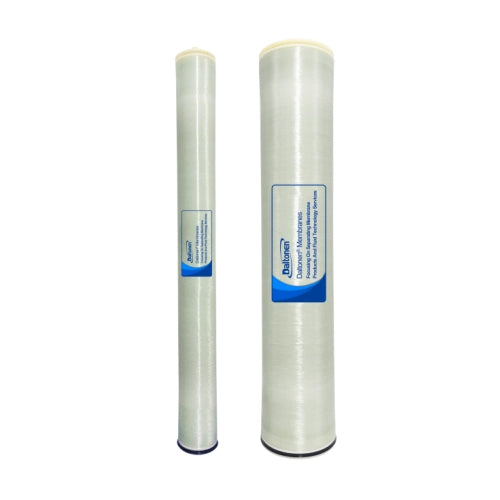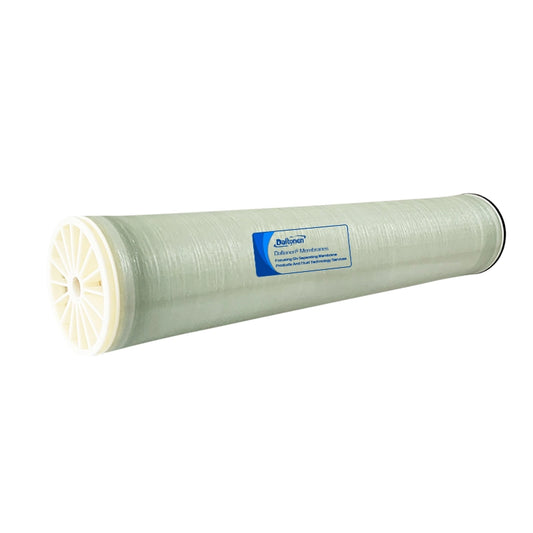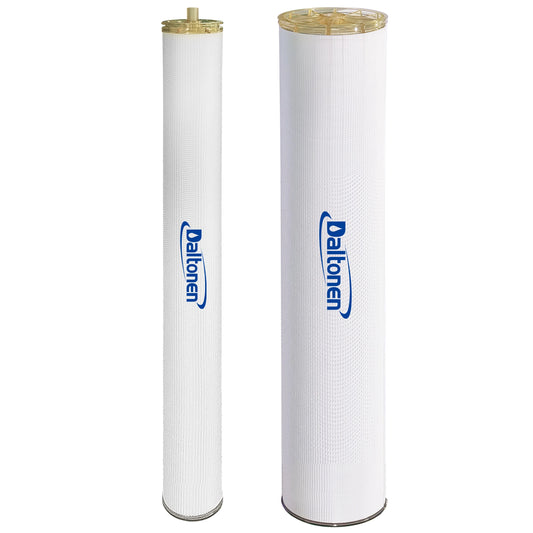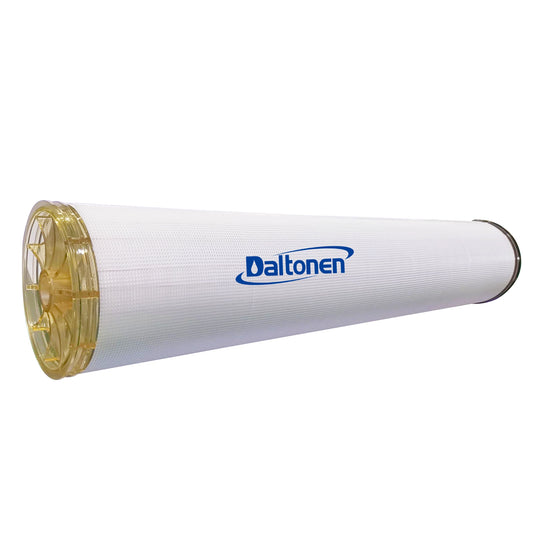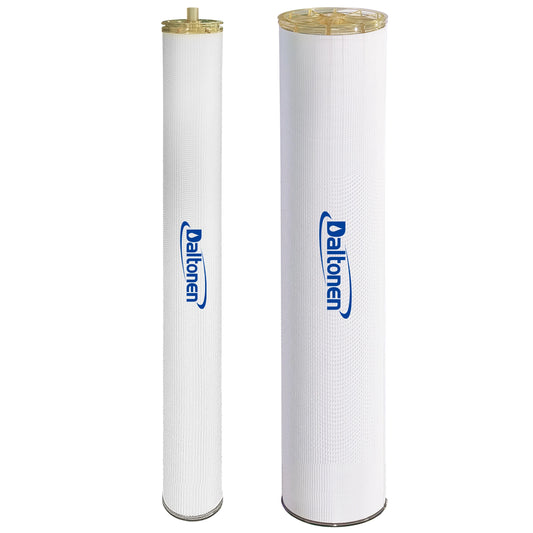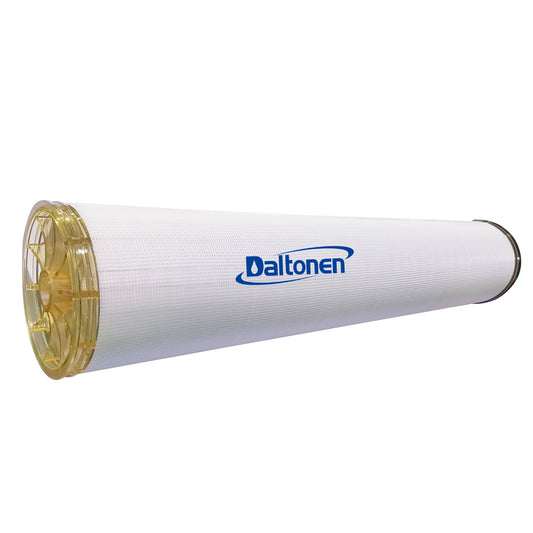Reverse Osmosis Membrane Recovery and Water Production Rate Relationship
Reverse Osmosis Membrane Recovery and Water Production Rate Relationship
- Basic Principle of Reverse Osmosis Membrane
1.1 Description of the Reverse Osmosis Process
Reverse Osmosis (RO) is a technology that utilizes a semi-permeable membrane to separate solvents (usually water) from solutes in a solution under pressure-driven conditions. During the RO process, feed water (brackish water) is pumped into the RO membrane elements, and the applied pressure causes water molecules to pass through the membrane while solutes (such as salts, organic matter, etc.) are retained, resulting in permeate, or product water, on the low-pressure side of the membrane; meanwhile, a concentrated solution, known as concentrate or brine, is obtained on the high-pressure side. Due to its high separation efficiency, RO technology is widely used in fields such as seawater desalination, wastewater treatment, and pure water production.

1.2 Definitions of Recovery Rate and Water Production Rate
Recovery Rate refers to the percentage of feed water that is converted into product water during the RO process. It is a key operational parameter that reflects the system's utilization efficiency of feed water. Water Production Rate, on the other hand, refers to the volume of water that passes through the RO membrane per unit of time, typically expressed in tons/hour or gallons/day, and it is directly related to the economic and practical aspects of the RO system.
The formula for recovery rate is:
Recovery Rate (%) = (Product Water Flow Rate / Feed Water Flow Rate) * 100%
The water production rate is closely related to the recovery rate. An increase in water production rate usually means more feed water is converted into product water, thereby increasing the recovery rate. However, this relationship is not linear, as an increase in recovery rate can also lead to a series of negative impacts.
- Increase in salt concentration on the membrane surface: As the recovery rate increases, the salt concentration on the membrane surface also increases, leading to an increase in osmotic pressure, which in turn reduces the rate of water molecule permeation. When the recovery rate increases, the salt concentration on the membrane surface can increase up to four times the salt concentration of the feed water, known as the concentration factor. This increase in salt concentration not only reduces the rate of water permeation but also increases the risk of membrane fouling.
- Increased risk of membrane fouling: Under high recovery rates, the concentration polarization phenomenon on the membrane surface intensifies, leading to faster membrane fouling. Membrane fouling can significantly reduce the permeability of the membrane, thereby reducing the water production rate. Therefore, although increasing the recovery rate can increase the water production rate, it must be done without sacrificing membrane performance.
- Changes in operating costs: High recovery rates may require higher operating pressures to overcome the increased osmotic pressure. This not only increases energy consumption but also increases the operating costs of the system. According to market research reports, for every 1% increase in recovery rate, energy consumption may increase by 2-3%, which is an important economic consideration for large-scale RO systems.
- Relationship between Recovery Rate and Water Production Rate
2.1 Impact of Recovery Rate on Water Production Rate
Recovery rate is an important indicator of the efficiency of the RO system and directly affects the water production rate. According to the basic principle of the RO membrane, an increase in recovery rate means more feed water is converted into product water. Specifically, an increase in recovery rate leads to an increase in product water flow rate, thereby increasing the water production rate. However, this relationship is not linear because an increase in recovery rate also brings a series of negative impacts.
2.2 Constraints of Water Production Rate on Recovery Rate
The water production rate, as the direct output of the RO system, has certain constraints on the recovery rate. An increase in water production rate needs to be carried out while ensuring membrane performance and system economy.
- Limitations of membrane materials and structure: Different membrane materials and structures have different effects on water production rate. Some membrane materials may undergo structural changes, such as compaction or deformation, under high recovery rates, which can reduce their water permeability, thereby limiting the increase in recovery rate.
- System design and operational parameters: System design, including the number and arrangement of membrane elements, as well as operational parameters such as pressure and temperature, will affect both water production rate and recovery rate. For example, by optimizing operational pressure and temperature, it is possible to increase water production rate and recovery rate without sacrificing membrane performance.
- Pre-treatment and cleaning maintenance: To maintain a high water production rate and recovery rate, pre-treatment and regular cleaning and maintenance of the RO system are crucial. Pre-treatment can reduce suspended solids and colloids in the feed water, reducing membrane fouling; while regular cleaning can restore the membrane's water permeability, maintaining a high water production rate and recovery rate.
In summary, there is a complex interaction between recovery rate and water production rate. In practical applications, it is necessary to consider factors such as membrane material characteristics, system design, operational parameters, and economic factors comprehensively to achieve the best recovery rate and water production rate.

- Factors Affecting Recovery Rate
3.1 Feed Water Quality
Feed water quality is one of the important factors affecting the recovery rate of the RO membrane. Dissolved solids (TDS), suspended solids, organic matter, and microorganisms in the water will all have an impact on the recovery rate.
- Dissolved Solids (TDS): The higher the TDS concentration in the feed water, the higher the osmotic pressure of the membrane, which reduces the rate of water molecule permeation, thereby reducing the recovery rate. For every 100 mg/L increase in TDS concentration, the recovery rate may decrease by 1-2%.
- Suspended Solids and Colloids: Suspended solids and colloids in the feed water can form a deposition layer on the membrane surface, increasing the filtration resistance of the membrane and reducing the permeation volume of water. when the concentration of suspended solids in the feed water exceeds 10 mg/L, the recovery rate significantly decreases.
- Organic Matter: Organic matter in the feed water may be adsorbed by the membrane, leading to membrane surface pollution and affecting its water permeability. Studies have shown that an increase in organic matter concentration can lead to a 3-5% decrease in recovery rate.
- Microorganisms: Microorganisms in the feed water can form a biofilm on the membrane surface, affecting the permeation of water. Feed water with microorganisms that have not been properly pre-treated can lead to a more than 5% decrease in recovery rate.
3.2 Operating Pressure
Operating pressure is another key factor affecting the recovery rate of the RO membrane. The magnitude of operating pressure directly affects the driving force for water molecules to pass through the membrane.
- Relationship between pressure and permeation rate: For every 1 bar increase in operating pressure, the permeation rate of water can increase by about 2-3%, thereby increasing the recovery rate. However, an increase in pressure also brings the risk of membrane compaction and membrane material fatigue, which may reduce the water permeability of the membrane.
- Economic considerations: Although increasing operating pressure can increase the recovery rate, it also increases energy consumption and operating costs.that for every 1 bar increase in operating pressure, energy consumption may increase by 1.5-2.5%, which is an important economic consideration for large-scale RO systems.
3.3 Membrane Element Characteristics
The characteristics of the membrane element, including membrane material, structure, and area, have a direct impact on the recovery rate.
- Membrane Material: Different membrane materials have different water permeability and anti-fouling capabilities. For example, polyamide membranes have high water permeability but are more susceptible to fouling, while cellulose acetate membranes have better pH tolerance but slightly lower water permeability.
- Membrane Structure: The structure of the membrane, such as hollow fiber membranes or spiral wound membranes, affects its hydromechanical characteristics and fouling tendency. Hollow fiber membranes, due to their high filling density, may show lower pressure drop under high recovery rates but are also more susceptible to fouling.
- Membrane Area: The effective membrane area of the membrane element directly affects its water production capacity. A larger membrane area can provide higher water production rate and recovery rate but also increases the initial investment cost of the system.
In summary, feed water quality, operating pressure, and membrane element characteristics are the main factors affecting the recovery rate of the RO membrane. When designing and operating the RO system, it is necessary to consider these factors comprehensively to achieve the best recovery rate and water production rate.

- Factors Affecting Water Production Rate
4.1 Feed Water Temperature
Feed water temperature has a significant impact on the water production rate of the RO membrane. Changes in temperature directly affect the viscosity and diffusion coefficient of water, thereby affecting the rate at which water molecules pass through the membrane.
- Relationship between temperature and water production: According to experimental data, for every 1℃ increase in feed water temperature, water production increases by about 2.5%-3.0%. This is because when the temperature rises, the kinetic energy of water molecules increases, and their diffusion performance is enhanced, leading to an increase in the number of water molecules passing through the membrane.
- Impact of temperature on desalination rate: Although an increase in temperature can increase water production, it may also lead to a decrease in desalination rate. Studies have shown that as the feed water temperature increases, the permeation rate of salts also increases, which is because the increase in temperature increases the diffusion rate of salts, thereby reducing the desalination efficiency of the RO membrane.
4.2 Feed Water pH Value
The pH value of the feed water also has a certain impact on the water production rate and desalination rate of the RO membrane, especially for certain types of membrane materials.
- Impact of pH value on water production: Within a certain pH range, water production is almost unaffected. However, beyond this range, especially when the pH value is below 4 or above 10, some membrane materials may be damaged, leading to a decrease in water production.
- Impact of pH value on desalination rate: Changes in pH value may affect the charge state of ions in the water, thereby affecting their ability to pass through the membrane. For example, changes in pH value may affect the removal efficiency of ions such as carbonates and sulfates.
4.3 Feed Water Salt Concentration
The salt concentration in the feed water has a direct impact on the water production rate and desalination rate of the RO membrane.
- Relationship between salt concentration and osmotic pressure: The higher the salt concentration in the feed water, the higher the osmotic pressure, which reduces the driving force for water molecules to pass through the membrane, thereby reducing the water production rate. Experimental data show that for every 100 mg/L increase in feed water salt concentration, the water production rate may decrease by 1-2%.
- Impact of salt concentration on desalination rate: Under high salt concentration, the concentration polarization phenomenon is more severe, which not only reduces the rate of water permeation but may also lead to scaling on the membrane surface, further reducing the desalination rate. Studies have shown that an increase in feed water salt concentration leads to a decrease in desalination rate, especially under high recovery rate conditions, which is more noticeable.
In summary, feed water temperature, pH value, and salt concentration are important factors affecting the water production rate of the RO membrane. In practical applications, it is necessary to adjust these parameters to optimize the performance of the RO system to achieve the best water production rate and desalination rate.
5. Optimization of Recovery Rate and Water Production Rate
5.1 System Design Considerations
During the system design phase, considering the optimization of recovery rate and water production rate is crucial. Here are several key design considerations:
- Selection and arrangement of membrane elements: According to technical documents from Qinsen High Technology, selecting the right membrane elements and optimizing their arrangement can significantly affect the system's recovery rate and water production rate. For example, using membrane elements with high desalination rate and high water flux can increase the water production rate while maintaining water quality. At the same time, the arrangement of membrane elements (series or parallel) also affects the recovery rate. Reasonable arrangement can reduce brine recycle and improve overall recovery rate.
- Design of pre-treatment unit: The design of the pre-treatment unit is crucial for reducing membrane fouling and increasing the system's recovery rate. Pre-treatment can effectively remove suspended solids, organic matter, and microorganisms from the feed water, reducing membrane surface pollution, thereby increasing the water production rate. Effective pre-treatment can increase the system's recovery rate by 2-5%.
- Brine recycle and reuse: Brine recycle technology can improve the system's recovery rate while reducing wastewater discharge. By recycling part of the brine back to the raw water pipeline or using it for other purposes, the utilization rate of water can be improved. Brine recycle can increase the system's recovery rate by 5-10%.
- System scale and number of membrane elements: The selection of system scale and the number of membrane elements needs to be determined based on water production requirements and water quality requirements. A larger system scale can increase the water production rate by increasing the number of membrane elements, but at the same time, the increase in cost and energy consumption must also be considered.
5.2 Adjustment of Operational Parameters
Adjustment of operational parameters is another way to optimize the recovery rate and water production rate. Here are several key operational parameters:
- Adjustment of operating pressure: Operating pressure directly affects the driving force for water molecules to pass through the membrane. Appropriately increasing operating pressure can increase the water production rate, but it also increases energy consumption. Therefore, a balance point needs to be found to achieve the best energy efficiency ratio.
- Control of feed water flow rate: The size of the feed water flow rate affects the flow rate on the membrane surface, thereby affecting the recovery rate and water production rate. Excessive feed water flow rate may lead to insufficient flow rate on the membrane surface, increasing the concentration polarization phenomenon and reducing the recovery rate.
- Cleaning frequency and method: Regular cleaning can restore the membrane's water permeability, maintaining a high water production rate and recovery rate. According to technical documents, choosing the right cleaning frequency and method is crucial for preventing membrane fouling and biofilm formation.
- Regulation of pH value and temperature: The pH value and temperature of the feed water need to be controlled within the appropriate range to maintain the stability and water production performance of the membrane. Improper control of pH value and temperature may lead to damage to the membrane material, reducing the water production rate.
By comprehensively considering system design and adjustment of operational parameters, the recovery rate and water production rate of the RO system can be effectively optimized, achieving efficient use of water resources and economical operation of the system.

6. Summary
In this chapter, we have delved into the relationship between the recovery rate and water production rate of the RO membrane and analyzed various factors affecting these two key parameters. By comprehensively considering feed water quality, operating conditions, and system design, we can draw the following conclusions:
6.1 Interdependence of Recovery Rate and Water Production Rate
The recovery rate and water production rate are directly related. Increasing the recovery rate usually means more feed water is converted into product water, thereby increasing the water production rate. However, this increase is not without limits. High recovery rates may lead to increased salt concentration on the membrane surface, thereby increasing osmotic pressure and the risk of membrane fouling. Therefore, while increasing water utilization, it is necessary to consider the maintenance of membrane performance and system economy.
6.2 Impact of Feed Water Quality on Recovery Rate and Water Production Rate
Feed water quality, including TDS, suspended solids, organic matter, and microorganisms, significantly affects the recovery rate and water production rate. High TDS concentration, suspended solids, and organic matter concentration, as well as the presence of microorganisms, can reduce the recovery rate and water production rate. Therefore, the design of the pre-treatment unit is crucial for improving the overall performance of the system.
6.3 Impact of Operating Pressure on Recovery Rate and Water Production Rate
Operating pressure is a key factor affecting the recovery rate and water production rate. Appropriately increasing operating pressure can increase the water production rate but also increases energy consumption and the risk of membrane compaction. Therefore, a balance point needs to be found to achieve the best energy efficiency ratio and membrane performance.
6.4 Impact of Membrane Element Characteristics on Recovery Rate and Water Production Rate
The material, structure, and area of the membrane element directly affect the recovery rate and water production rate. Selecting the right membrane elements and optimizing their arrangement can significantly affect the system's recovery rate and water production rate. At the same time, the effective area of the membrane element also directly affects its water production capacity.
6.5 Optimization of System Design and Operational Parameters
By optimizing system design and adjusting operational parameters, the recovery rate and water production rate of the RO system can be effectively optimized. This includes selecting the right membrane elements, optimizing the pre-treatment unit, implementing brine recycle technology, and adjusting operating pressure and feed water flow rate.
In summary, the recovery rate and water production rate of the RO membrane are influenced by various factors, and it is necessary to comprehensively consider feed water quality, operating conditions, and system design to achieve the best water treatment effects and economic benefits. With reasonable design and operation, it is possible to increase water resource utilization while maintaining membrane performance and system economy.
